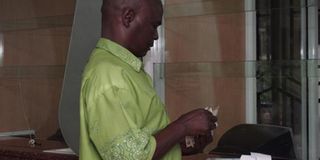Fraud: How they did it

A client transacts business at a counter in a bank. Account holders should verify the amount of money they withdraw at the counter before leaving with it. FILE PHOTO |
What you need to know:
- The fraud entails outsiders colluding with bank employees to siphon funds from accounts of unsuspecting clients.
Banking fraud is the most common form of financial crimes perpetrated in Kenya.
According to PricewaterhouseCoopers(PwC), outsiders colluding with internal employees are the key actors in these crimes.
So how do they do it?
The Nation spoke with three bankers who shared their experiences. Their names cannot be published for confidential reasons.
*Case A
In a bank in Nairobi, three incidents are being investigated after ghost accounts mysteriously withdrew money from active accounts.
For insiders, this is easy because they have the leeway to do cash transfers to other accounts. For example, those handling deposits and withdrawals over the counter are allowed to make these transfers.
But while there are strict procedures to follow such as proof of identification and signatures, some of them open ghost accounts in collusion with the Information Technology people. They then transfer money to ghost accounts, withdraw it later and delete the accounts with ease.
The system in place to fight this vice includes an electronic audit of figures of transactions from every working station in every branch.
It is all-integrated and every ATM has cameras recording who comes into the lobby. Normally, you get caught before stealing for too long and the safest customers are those transacting online because for them, the security codes they are given changes every five seconds.
The bad thing is that management chooses to deal with the case internally rather than take it to the police and be exposed to a court process. It is also an image protection move.
*Case B
I have been working in this bank for three years. Some people grew rich overnight, driving cars that only a person in a certain salary scale can drive.
Nobody suspected anything until one day last year, a colleague was found to have been deducting amounts of less than ten shillings from all clients who visited his counter.
The trick worked this way: A client seeks a transaction from the counter, say, a deposit of an amount that has extra coins on top. This is common especially with utility payments. Most clients may not worry to check whether they need a change of Sh10 or Sh7. These small amounts often end up in the cashier’s pockets.
The fraud went unnoticed for some time because he was defrauding clients who had no time for the little change.
Unfortunately, he was depositing the money in an account and it reached a point where the deposits were so consistent that the bank became curious.
When an audit was conducted, it was discovered he had been stealing both ways; from the bank and the clients. He had to go, and the case was hushed up.
*Case C
It is generally difficult to defraud my bank because there are stringent checks. For example, to open an account, you need an ID. For deposit of more than Sh200,000, you must make a declaration of source of funds. When withdrawing more than Sh400, 000, the branch manager has to approve that kind of transaction, often after an interrogation.
Still, these measures get beaten from time to time and it is the Security Department that often does the investigation and recommends what is to be done.
But most cases do not get published or reach police as it places the bank’s reputation at risk.
After investigations, customers are paid back their money and the bank seeks compensation from the insurer. The staff involved may lose their jobs though.
Previous cases of fraud have involved two ways. One was a case in which a member of staff stole bank security information using a portable disk.
It contained various active accounts which were later emptied.
When the matter was investigated, it was discovered the electronic break-in was done at another branch of the same bank.
It was a joint venture between inter-branch employees. Customers were quietly paid back their money.
The second scenario is the most common. Bank tellers sometimes take advantage of the illiteracy or hurry of clients and simply ask them to sign any document.
For example, in money transfer services where a customer was asked to sign, documents show they received a certain amount only to receive less.
In one case last year, an elderly woman was asked to sign for Sh32,000 only to receive Sh22,000. The problem is one is supposed to count the money at the counter, because no correction can be done once you walk out and return later to complain.



